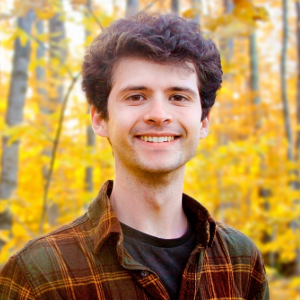
March 2024 Newsletter

March 2024 Newsletter

Student Profile
Joseph Salvo, PhD student, Northwestern University’s Interdepartmental Neuroscience (NUIN) program.
Initially torn between astrophysics, marine biology and neuroscience, Joseph Salvo, a PhD student in Northwestern University’s Interdepartmental Neuroscience (NUIN) program, eventually found himself studying neural cells in the cerebellum.
After completing his B.A. in Neurobiology and English from Northwestern, Salvo joined the laboratory of Rodrigo M Braga, PhD, assistant professor of Neurology in the division of Epilepsy and Clinical Neurophysiology, where he now uses MRI brain mapping to investigate the parts of the brain involved in reading.
Where is your hometown?
I’m an East-Coaster from Schenectady, NY, about three hours north of New York City by car. A fun fact is that the town was once home to General Electric’s first headquarters.
What sparked your interest in science or medicine?
As a kid, my favorite parts of science were the mysterious ones. I was most interested in neuroscience, marine biology, and astrophysics, because those fields seemed to ask the deepest questions about reality. Neuroscience ultimately won out for me because it felt most personal to the human experience.
What are your research interests?
I began my research career studying neural cell populations in mouse cerebellum that could play a role in decision-making. I’ve since transitioned to study language and reading in humans using magnetic resonance imaging (MRI), first in the cerebrum and now in the cerebellum. In both cases, my underlying drive has been understanding the cells and connections that allow for complex behaviors. I’m curious whether cognitive behaviors we assume to be innately human (like language) have underlying features that can be found in other animals, or perhaps even in artificial intelligence.
What are you currently working on?
I’ve been using fMRI to map brain regions involved in the steps of reading. Specifically, I’ve been identifying cortical regions that respond to language, as well as regions that respond to written words and word-like images. I then map those regions to test whether they overlap with each other within individual people.
About a year ago we scanned eight participants as they were shown examples of language, and completed tasks related to thinking and reading. The results have shown a unique region in the inferior-temporal cortex, shared between language and written-word processing, which could be a stepping-stone between seeing words and understanding their meaning. More recently, I’ve been investigating whether similar spatial arrangements can be found in the cerebellum.
Please tell us about a defining moment in your education at Feinberg thus far.
Two moments stand out as particularly memorable. The first was in March of 2021; I had recently joined my thesis lab but had been working remotely for the past two months. Despite seeing their faces every day, I’d never met my PI or my colleagues in person. I remember the first day I was able to walk into the lab that would become a home away from home for the next three years. It’s one thing to conduct analyses while on your couch and another to work in a place intended for pushing the boundaries of scientific knowledge. Having a desk waiting for me in the lab space made me feel like a real researcher.
The second experience happened more recently. The NUIN program hosts an annual retreat, with research talks from current students. As a first-year grad student, I had been inspired by the confidence of these student presenters. This year I was chosen to do a presentation of my own. It was both gratifying and humbling to stand on stage and think about the path that had guided my walk from a place in the audience to a place behind the podium.
What do you hope to do with your degree?
During grad school I’ve become more interested in science communication. I’ve been working with kids in a middle-school science club and have been recording a podcast (“Reading Between the Science”) that gives young scholars the chance to present journal clubs to non-experts. For the past couple years, I’ve organized the Cognitive Brain Mapping Group’s weekly lecture series. Last month I moderated a panel discussion I’d arranged on “What we can learn about language from AI”. In my free time, I make art based on MRI images. I’ve been grateful for the opportunities to share my work while learning from others, and have especially enjoyed creating settings for these types of discussions. My dream job would give me the freedom to build spaces for scientific conversations while concurrently pursuing my research interests.